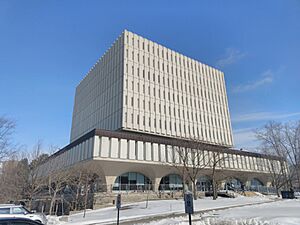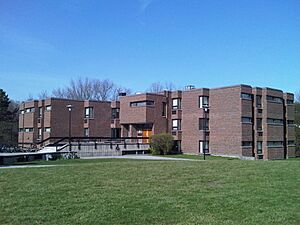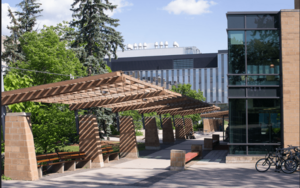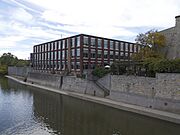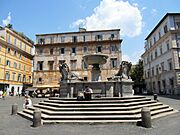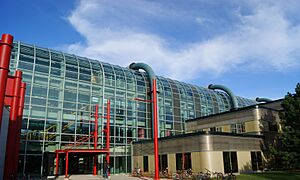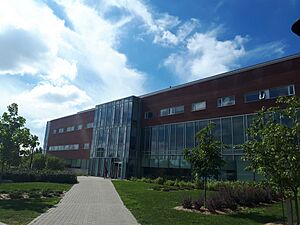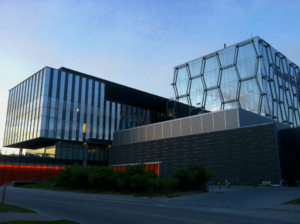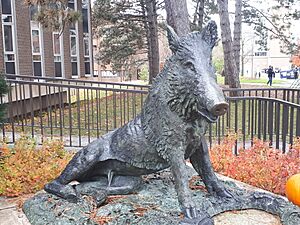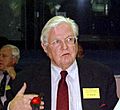University of Waterloo facts for kids
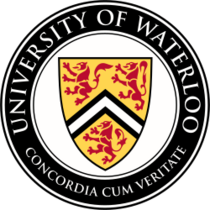
|
||||
|
Former names
|
Waterloo College Associate Faculties (1956–1959) | |||
|---|---|---|---|---|
| Motto | Concordia cum veritate (Latin) | |||
|
Motto in English
|
In harmony with truth | |||
| Type | Public research university | |||
| Established | 1959 | |||
|
Academic affiliations
|
ACU, CARL, COU, CUSID, Fields Institute, Universities Canada, U15 | |||
| Endowment | CA$557.6 million (2024) | |||
| Chancellor | Jagdeep Singh Bachher | |||
| President | Vivek Goel CM | |||
| Provost | James Rush | |||
|
Academic staff
|
1,355 | |||
|
Administrative staff
|
2,691 | |||
| Undergraduates | 34,204 | |||
| Postgraduates | 6,309 | |||
| Location |
,
,
Canada
43°28′8″N 80°32′24″W / 43.46889°N 80.54000°W
|
|||
| Campus | Urban, 450 hectares (1,112 acres) | |||
| Colours |
|
|||
| Nickname | Warriors | |||
|
Sporting affiliations
|
U SPORTS, OUA | |||
| Mascot | King Warrior | |||
 |
||||
The University of Waterloo (often called UWaterloo or UW) is a public research university in Waterloo, Ontario, Canada. Its main campus is a large area of land next to uptown Waterloo and Waterloo Park. The university also has three smaller campuses in other cities and four colleges connected to it.
Waterloo is famous for having the world's largest co-operative education program. This program lets over 20,000 students switch between studying in class and working at a real job. The university is also part of the U15, a group of Canada's top research universities.
The school started in 1956 as the Waterloo College Associate Faculties. It was created to train engineers and technicians for Canada's growing economy after the war. It officially became the University of Waterloo in 1959.
In 2020, about 36,000 undergraduate students and 6,200 graduate students attended the university. Its graduates live and work all over Canada and in more than 150 countries. The university's sports teams are called the Waterloo Warriors and they compete against other universities in U Sports.
Contents
History of the University
How it Started in the 20th Century
The University of Waterloo began as part of Waterloo College (which is now Wilfrid Laurier University). In 1953, the president of Waterloo College, Gerald Hagey, wanted to make the school bigger. At the time, the government did not give money to schools that were connected to a church.
Hagey learned that McMaster University had created a separate, non-church college to get government funding. He decided to do the same thing. On April 4, 1956, he created the Waterloo College Associate Faculties. This new part of the college focused on co-operative education, an idea from a man named Ira Needles. This program mixed classroom learning with real work experience in industries.
In 1957, the first students were admitted. A year later, the school bought a large piece of land and opened its first building, the Chemical Engineering Building.
In 1959, the government of Ontario passed a law that officially separated the Associate Faculties from Waterloo College. This created the new University of Waterloo. The new university was set up to have a senate for academic rules and a board of governors for money and other decisions.
The university grew quickly. It added a Faculty of Arts in 1960. In 1967, it created the first Faculty of Mathematics in North America and the world's first department of kinesiology (the study of human movement).
The University in the 21st Century
In 2001, the university started building the David Johnston Research and Technology Park on its north campus. The park was designed to be a home for high-tech companies. This gives businesses access to the university's professors, co-op students, and resources.
From 2009 to 2012, the university also had a campus in Dubai, in the United Arab Emirates. It offered degrees in engineering and business. The university decided to close the Dubai campus in 2012.
In June 2023, a serious incident happened on campus where a professor and two students were injured in a classroom. Police investigated it as a hate-motivated event.
Campus Life and Buildings
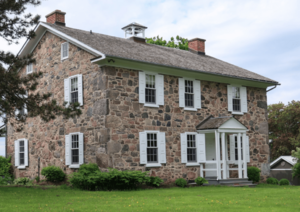
The main campus of the university is located in the city of Waterloo. It is on land that is part of the Haldimand Tract, which was land promised to the Six Nations people.
Most of the university's main buildings were built in the 1960s and are located inside a large ring road. The campus is divided into three areas: South Campus, North Campus, and Northwest Campus. The South Campus is where most of the teaching happens. The North Campus has the Research and Technology Park. The Northwest Campus is mostly fields and a nature reserve.
The oldest building on campus is the Graduate House, which was a farmhouse built in the 1800s. The first building made for the university was the Douglas Wright Engineering Building in 1958.
Libraries and Museums
The university has four libraries with over 1.4 million books and many online resources. The three main libraries on campus are the Dana Porter Library, the Davis Centre Library, and the Witer Learning Resource Centre. The fourth library, the Musagetes Architecture Library, is in the city of Cambridge.
Waterloo also runs the Earth Sciences Museum on campus. It is a teaching museum for local schools and science groups. It has exhibits on the Great Lakes, dinosaurs, and Ice Age animals. There is even a full cast of an Albertosaurus skeleton.
Student Housing
The university has eight residences for students to live in. The first one, Village 1, was built in 1966. The largest residence is UW Place, which can house over 1,600 students. Students can also live in residences at the affiliated colleges. About one-quarter of all undergraduate students live on campus.
The Student Life Centre is a central hub for students. It has spaces for clubs, studying, and eating. It was expanded in 2021 to connect with the Physical Activities Complex, adding even more space for students.
Off-Campus Buildings
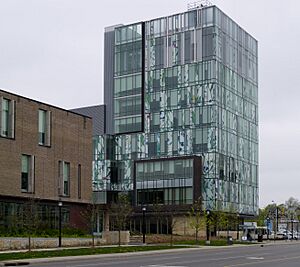
The university has campuses and buildings in other cities too. In Kitchener, there is the School of Pharmacy and the Centre for Extended Learning.
In Stratford, Ontario, the university has the Stratford School of Interaction Design and Business. This campus focuses on digital arts and media.
The School of Architecture is located in Cambridge, Ontario. The school moved there in 2004. It also has a studio in Rome, Italy, where fourth-year students can study.
How the University is Run
The university is run by two main groups: a Board of Governors and a Senate. The Board of Governors is in charge of the university's money and property. The Senate sets the educational rules and policies.
The president is the head of the university. They manage the day-to-day business of the school. As of July 1, 2021, the president is Vivek Goel. The chancellor is another important leader who presides over graduation ceremonies. The current chancellor is Jagdeep Singh Bachher.
The university also has three affiliated colleges and one federated university. These are smaller schools connected to Waterloo that have their own unique character, often with religious roots. They include Conrad Grebel University College, Renison University College, and St. Jerome's University.
Academics at Waterloo
Waterloo is a public university that is known for its research. It is organized into six large departments called faculties, which include many smaller schools and departments.
The university offers many ways for students to get financial aid, including loans, grants, and scholarships from the government and the university itself.
Co-operative Education Program
Waterloo has the largest co-op program in the world. Over 20,000 students are part of it. In the co-op program, students switch between terms of studying and terms of working at a paid job.
For many programs, like engineering, doing co-op is required to graduate. Students usually have to complete four or five work terms. They are responsible for applying for jobs and going to interviews.
At the end of each work term, the employer gives the student a performance review. Co-op students earn money during their work terms, which helps them pay for their education. In 2018, the average student earned about $12,100 per work term.
Rankings and Reputation
Waterloo is often ranked as one of the top universities in Canada and the world. In 2024, the QS World University Rankings placed it 115th in the world and fifth in Canada. Maclean's magazine ranked Waterloo third in its "comprehensive university" category in 2023.
The university is especially known for how well its graduates do in finding jobs. A QS ranking in 2022 placed Waterloo 24th in the world for graduate employability. Many tech companies in Silicon Valley hire graduates from Waterloo. A director at Google once said that Waterloo is one of their top recruiting universities in the world.
Research and Innovation
As a member of the U15 group of research universities, Waterloo is a major centre for research. In 2017, it received over $189 million in funding for research projects.
The university has over 40 research centres and institutes. These include the Institute for Quantum Computing and the Waterloo Institute for Nanotechnology. It also partners with other organizations on research, such as the Balsillie School of International Affairs and companies like Microsoft and Facebook.
Student Life
Student Groups and Clubs
The two main student unions are the Waterloo Undergraduate Student Association (WUSA) and the Graduate Student Association (GSA). WUSA supports over 200 student clubs. These clubs cover everything from hobbies and sports to cultural groups.
Each faculty also has its own student society. These societies offer services like exam help and workshops. They also run small shops that sell coffee and food.
Athletics
The university's sports teams are called the Waterloo Warriors. They compete in the Ontario University Athletics conference. The teams include basketball, football, hockey, soccer, swimming, and volleyball.
The main stadium is Warrior Field, which can seat 5,400 people. The university also has a large Physical Activity Complex with gyms and a swimming pool, and the Columbia Ice Field for hockey.
Entrepreneurship
The university helps students, staff, and alumni start their own companies through a program called Velocity. It is the largest free startup incubator in the world. It provides office space, labs, and business advice to new companies.
Many successful companies have come out of Waterloo, including Pebble and Kik Messenger. In 2017, a report ranked Waterloo's undergraduate program fourth in the world for producing founders of "unicorn" startups (companies worth over $1 billion).
Symbols and Traditions
The university's official colours are black, gold, and white. These colours are on the university's coat of arms, which has been used since 1961.
The coat of arms features two red lions on a gold background. These were inspired by the Duke of Wellington, who won the Battle of Waterloo. The black and white chevron pays respect to the German heritage of the Kitchener-Waterloo area.
The university's motto is Concordia cum veritate, which is Latin for "In Harmony with Truth".
Each faculty also has its own symbols. Math students are known for wearing pink ties. The Faculty of Arts has a bronze pig statue named Porcellino as its mascot.
Notable People
Over 221,000 people have graduated from the University of Waterloo. Many have become famous in business, science, arts, and sports.
-
David Johnston, former Governor General of Canada and president of the university.
-
Robert Mundell, won the Nobel Prize in Economics.
-
Donna Strickland, won the Nobel Prize in Physics.
-
Chris Hadfield, a retired Canadian astronaut.
-
Mike Lazaridis, founder of BlackBerry Limited.
-
Kevin O'Leary, businessman and television personality.
-
Chamath Palihapitiya, CEO of Social Capital and part-owner of the Golden State Warriors.
- Donna Strickland is a professor at the university who won the Nobel Prize in Physics in 2018 for her work with lasers.
- Robert Mundell won the Nobel Memorial Prize in Economic Sciences in 1999 for his work on currencies.
- Mike Lazaridis founded Research in Motion (now BlackBerry).
- Chris Hadfield is a famous Canadian astronaut who studied at Waterloo.
- Rupi Kaur is a best-selling poet and author who graduated with an English degree.
- Kevin O'Leary is a well-known businessman and TV personality.
- David Johnston, a former president of the university, served as the Governor General of Canada from 2010 to 2017.
Images for kids
See also
 In Spanish: Universidad de Waterloo para niños
In Spanish: Universidad de Waterloo para niños
- J. W. Graham Medal
- Midnight Sun Solar Race Team
- University of Waterloo Nano Robotics Group
- Waterloo Global Science Initiative




